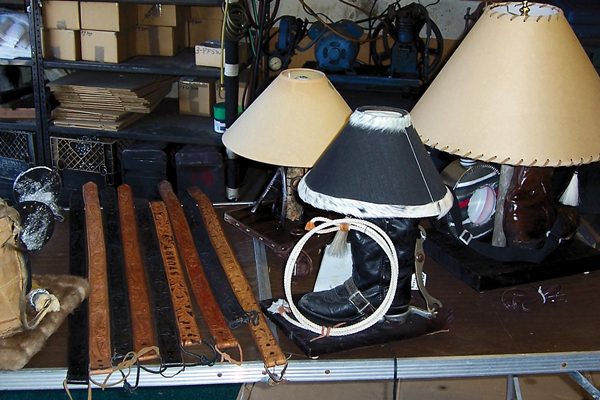 In his work on more than 100 films, Bud Cardos has done it all: stuntman, actor, unit production manager, line producer and director.
In his work on more than 100 films, Bud Cardos has done it all: stuntman, actor, unit production manager, line producer and director.
Even though Cardos has a penchant for movies, he hasn’t strayed far from his love of the West.
At 17, he was in charge of 135 head of horses at Bob’s Stables in California. Years later, riding bareback on bulls convinced him he wasn’t quite cutting it, so he decided to become a rodeo clown instead. During those five years, he met rodeo cowboy Bill Ward, who was also a saddlemaker at McPherson Saddle Works. Ward inspired Cardos to open up his own saddle shop. “He took me under his wing and taught me a lot,” 78-year-old Cardos admits. Eventually Cardos changed his business focus to crafting Western art pieces, such as picture frames, lamps and home furnishings, from his home in Reseda, California.
“After many years of being involved with Western culture, horses, the movies, the art of working with leather just came natural,” Cardos says. “Most of my works are authentic, one-of-a-kind pieces. Feathers, skulls, horns; no plastic or moldings.”
And when he says “many years,” Cardos means it. By age five, he had already begun his acting career at MGM Studios. He went uncredited for his stunts in 1969’s The Wild Bunch, but he got the credit he deserved when he directed 1992’s Legends of the West. Jack Palance and Floyd “Red Crow” Westerman respectively followed pop culture portrayals of the O.K. Corral and the Battle of the Little Bighorn. Brooke Shields even introduced a segment on dance hall girls. For Cardos, the project earned him a place in the National Cowboy Hall of Fame in Oklahoma City.
His Hollywood connect-ions certainly don’t hurt his business. Dick Clark, Miguel Sandoval and Patricia Arquette have purchased Cardos’ products.
818-343-4077
White’s Electronics
Headphones create a problem in rattlesnake country.
Olive and Ken White, Sr., discovered that in 1950, when they were using the Geiger Counters available at the time to search for uranium, which was in high demand. So Ken designed a new counter that wouldn’t interfere with their search for the ore in the West and decided to market it to others. In the company’s eighth year, the U.S. government announced it would no longer purchase uranium.
A dealer from Tombstone, Arizona, though, called in and persuaded Ken to build him a metal detector, marking the beginning of White’s Electronics as the public knows it today.
Still based in Sweet Home, Oregon, with Ken, Jr., at the helm, the company has expanded its business to include new models geared for prospecting and water hunting. A general purpose model is your best bet if you plan on nugget shooting, beach combing and hunting for relics; otherwise, you should find a model that is built for what you will use it for the most. Today’s metal detectors start for under $200 and are lightweight, with turn-on-and-go operation. Best of all, they’ve entered the 21st century
with digital screens that indicate what’s in the ground and then show how deep to dig. White’s detectors can be found on both sides of the Atlantic—from authorized dealers nationwide or in the United Kingdom.
Customers still write in, sharing their stories of finding an 1852 dollar gold coin with their MXT or even finding a brooch in a tobacco patch using White’s XLT. One customer in Missouri found an eight-diamond wedding band set from the 1920s, appraised for more than $3,500, but when he took it home to his wife, she grabbed it and said “It’s mine.”
Whether you’re hunting for treasure to sell or keep, go with the maker who enjoys nearly 60 percent of the detector market in the United States.






